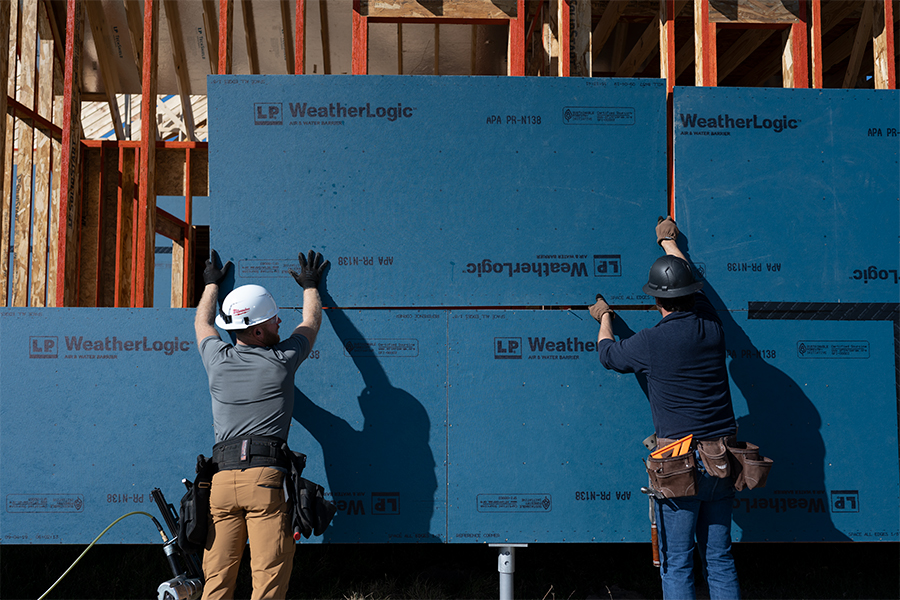Business Advice3 min
A Structural System Approach to Moisture Management
As builders set their sights on constructing more durable and resilient homes, combating moisture concerns-both during and after the build-is critical. Let's see how professionals are using exterior sheathing as a one part of their moisture management solution.
LP WeatherLogic® Air & Water Barrier works to help keep water and air out with an integrated, water-resistive overlay when sealed with seam and flashing tape. Not only does it install like regular sheathing, there's no need to go around the house a second time adding housewrap.
IS SHEATHING WATERPROOF?
Waterproof adhesives, which are added to OSB and plywood sheathing, do not degrade in the presence of water. While no wood-based sheathing can be completely waterproof, using a water-resistive barrier product like LP WeatherLogic panels can help manage moisture for a structure.
That's why many builders—like Jordan Smith, Chief Builder & Owner of Smith House Company—use LP WeatherLogic sheathing on their new builds. While LP WeatherLogic panels aren't fully waterproof, they do go a long way in preventing and reducing water intrusion.

"With the WRB fully integrated on top of an OSB sheathing product, I have a fully adhered water-resistive barrier on top of my structural sheathing," he explains. Smith finds that installation with LP WeatherLogic sheathing is fast and easy.
“I don't have to worry about water getting behind a housewrap product,” Smith adds. “That coupled with the 30-year limited warranty gives me the peace of mind that this build will last a long time.”
LP WeatherLogic Tape
LP WeatherLogic Seam & Flashing Tape helps create a tight seal to help keep air and water out. "When the air comes in, it also brings in moisture, which can cause damage," explains Smith.
Certified to AAMA 711-13, LP WeatherLogic Seam & Flashing Tape features one of today's highest quality adhesives. Tape rolls are included with panels and come in 3-3/4-inch and 6-inch widths. The wider Seam & Flashing Tape is used for window flashing and inside and outside corners. Check out the complete LP WeatherLogic installation instructions for more tape usage direction. Smith offers installation tips in this video.
Flashing Tape Versus Traditional Flashing**—Is There a Difference?**
Off-the-shelf housewrap and flashing help avoid water and air infiltration; however, there is no assurance water can't get behind, collecting around windows and doors and wreaking havoc.
Construction Instruction, an independent building science group, conducted side-by-side testing with LP WeatherLogic panels and commodity-grade weather-resistive barrier over standard OSB sheathing. A standard window was installed with LP WeatherLogic tape on one side and window flashing tape on the other. After simulating a 50 mph rainstorm for 15 minutes, the team found the commodity-grade housewrap leaked into the wall cavity while the side with LP WeatherLogic panels showed no signs of water intrusion.
Water-resistive installation is fast and easy, but it's important to apply LP WeatherLogic Tape correctly so it doesn't limit the 30-year limited warranty coverage. Here are three mistakes to avoid when installing the panels and LP WeatherLogic Seam & Flashing Tape.
Want to learn more about managing moisture problems in your commercial or residential builds? Discover what can cause water damage to engineered wood.
Continue Reading
Resiliency Solutions
5 minIntroducing LP® SmartSide® ExpertFinish® Naturals Collection™: Nature-Inspired Beauty Meets Engineered Performance
We're excited to introduce the LP® SmartSide® ExpertFinish® Naturals Collection™, a bold new addition to our trusted line of engineered wood siding and trim that delivers the warmth and beauty of nature with the advanced protection and performance builders and homeowners expect.
Labor Solutions
5 minChoosing the Right LP® Structural Solutions Product for Your Build
When it comes to building strong, reliable, and high-performing structures, the materials you choose matter. At LP Building Solutions, we understand that every project, whether it's a single-family home or a multifamily development, requires structural components that meet your needs for strength, durability, and efficiency.
Sustainability Solutions
5 minBuilding a More Sustainable Future with LP Building Solutions
In today's world, sustainability is no longer just a buzzword, it's a blueprint for responsible living and smarter building. As the construction industry seeks ways to reduce its environmental footprint, LP Building Solutions is focused on providing innovative building materials for eco-conscious builders to help reshape what it means to build sustainably
News & Stories3 min
History of Partnership with Gary Sinise Foundation
The LP Foundation is a proud partner of the Gary Sinise Foundation, which supports wounded veterans in several ways. You can learn more about the LP Foundation here.